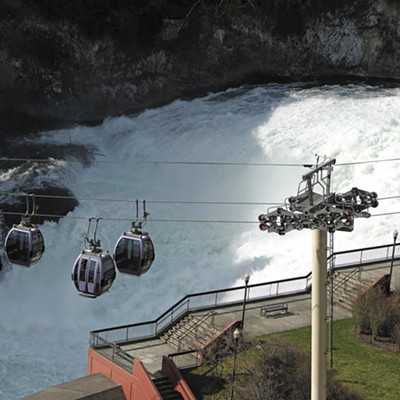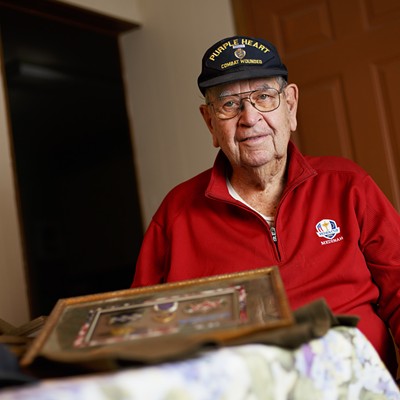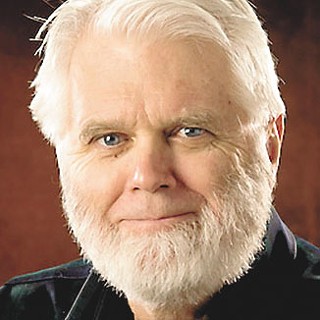Saving Cheney
[
{
"name": "Broadstreet - Instory",
"insertPoint": "5",
"component": "25846487",
"requiredCountToDisplay": "5"
},{
"name": "Broadstreet - Instory",
"insertPoint": "10",
"component": "25846487",
"requiredCountToDisplay": "10"
},{
"name": "Broadstreet - Instory",
"insertPoint": "15",
"component": "25846487",
"requiredCountToDisplay": "15"
},{
"name": "Broadstreet - Instory",
"insertPoint": "20",
"component": "25846487",
"requiredCountToDisplay": "20"
}
]
by Robert Herold
This is one of those good news, bad news columns. The caravan of folks who have made their way to the Seahawks' training camp in Cheney this summer are seeing both sides.
First, the good news: the Eastern Washington University campus. Never has it looked so sparkling, so beckoning. Over the past decade, the campus has been dramatically restored, expanded and transformed. With the recent completion of the Monroe Hall project, almost all of the wonderful older buildings -- Eastern has a surprising number of buildings on the Historic Register -- have been brought back to life.
No doubt the many Seahawks fans who might not be familiar with the school have come away impressed.
It's worth the short trip out to Cheney if only to see the restored Showalter Hall auditorium. Those whose memories go back a few decades remember a kind of shabby place into which dimmed-down and diffuse light fought its way through ugly glass bricks. And the layers of cosmetics added in the '50s, '60s and '70s weren't any help either. Then came the restoration, and instead of reinventing the wheel, those involved dug out the original plans and drawings. Out went the glass bricks, in came real windows. Out went the tacky carpeting to be replaced by tasteful runners and hardwood floors. The chairs are wonderful to behold, as is the d & eacute;cor throughout. And downstairs, what so few years ago was a dreary, nondescript room used primarily to register students has now become a second auditorium, complete with grand entryway from the main floor.
Today, thanks in no small part to President Steve Jordan's interest and leadership, the Spokane Symphony plays annually at Showalter Auditorium, where only a few years back the room was little more than a dreary embarrassment.
The visitor might then move on to the Kennedy Library, which, following the recent expansion, has almost doubled in size. The ALSC architects who did the job even managed to remove from the existing structure most of the cheap and trite ugliness that was so typical of '60s architecture. They provided us a very tasteful look, together with good lighting and nicely scaled interior spaces supported by solid materials throughout.
The main quadrangle, which sits directly in front of the library, was accordingly redefined, shifted, expanded and landscaped. Originally constructed in the late '60s, the "quad" was done on the cheap. The bricks were too thin to last. The trees were largely of the junk variety, the landscaping minimal. But no longer. Today, along with a significant commons, in the center now sits a very nice water sculpture.
The renaissance started under former President Mark Drummond, with most of the credit going to two people: Michael Stewart, then Eastern's Vice President for Budget and Finance, and George Durrie, the current Director of Governmental Operations.
Stewart, for the better part of a troubled decade, showed his genius at working the capital budget before legislators and staff in Olympia who had enormous respect for him and his efforts. At a time when the university's operating budget was under siege because of serious enrollment decreases, Stewart would return from session after session with another dozen or so projects having been mysteriously funded. His partner during the sessions was George Durrie. Together, the Stewart-Durrie team performed (especially under the circumstances) a miracle.
But it wasn't just the funding that Stewart provided; he also oversaw the projects. In this role, he showed great respect and sensitivity for Eastern's late-19th century and early-20th century architectural heritage. Because he did, 50 years from now it will be Stewart's imprint that continues to define the campus. (It should be mentioned, too, that more work remains to be done. Stewart left before he completed his dream -- major overhauls of the two '60s dormitory disasters known as "The Round Dorms." In Stewart's plan, these buildings were to be given a brick face lift, then joined together up through the third floor.)
Now for the bad news.
I refer to Cheney. The town remains, in the memorable words of Bob and Ray, little more than "a heck of a place, a spec of a place out near the freeway interchange."
Cheney has always been less than a real town, but always more than a strip commercial development (but, alas, not by much). The town remains in desperate need of what might be termed vertical commercial development. Instead, due perhaps to a lack of resources and leadership, it has managed to attract what fits the description of horizontal development, that is "strip" commercial development, which is moving ominously up the access highway that connects Cheney to I-90.
Indeed, the commercial-strip pincers movement has begun. Out by the interchange, we now find a brand-new car dealership.
It's not hard to envision this becoming a replay of the commercial growth pattern we watched in the Spokane Valley.
But the war hasn't been lost yet. Almost five miles of picturesque open land remain as a green belt between Cheney and Interstate 90. If growth management means anything at all, Spokane County will see to it that the strip-zone development between the recent expansion and the interchange goes no further. But to halt this long-running accommodation of the automobile will require a relentless focus of political will -- not a common currency in and around Spokane.
Even apart from the problems caused by the availability of cheap agricultural land, the town faces a difficult challenge. It doesn't enjoy the built environment of, say, Ellensburg (home of Central Washington University, and a surprisingly urban space), nor even a smaller, poorer town such as Toppenish, that has in recent years staged an up-by-the-bootstraps downtown revival of its own.
What in Cheney passes for the historical district, alas, seems little more than a rundown joke: Old buildings squatting beneath a cheap tin awning that should embarrass any town father. Moreover, because of the town's relative proximity to Spokane, shoppers are not island-bound as they are in Ellensburg.
But all this said, no small urban space in Spokane County has such an opportunity to develop as a model urban area with architectural definition and commercial vitality. If the sprawl can be contained, if the political and business leadership can be found, Cheney may be the place where, over the next quarter-century, we might see all the best hopes of growth management unfold.
One thing is for certain: Because of the work of Mike Stewart and George Durrie, the university has done its part to set the stage. Today, as the Seahawks' visitors have seen, Eastern Washington University sports a very serious small-university campus. The town -- with Spokane County's help -- should take advantage of the opportunity, rather than merely exploit it.
Prior to his retirement earlier this year, Robert Herold
was Vice Provost for Eastern Washington University.
This is one of those good news, bad news columns. The caravan of folks who have made their way to the Seahawks' training camp in Cheney this summer are seeing both sides.
First, the good news: the Eastern Washington University campus. Never has it looked so sparkling, so beckoning. Over the past decade, the campus has been dramatically restored, expanded and transformed. With the recent completion of the Monroe Hall project, almost all of the wonderful older buildings -- Eastern has a surprising number of buildings on the Historic Register -- have been brought back to life.
No doubt the many Seahawks fans who might not be familiar with the school have come away impressed.
It's worth the short trip out to Cheney if only to see the restored Showalter Hall auditorium. Those whose memories go back a few decades remember a kind of shabby place into which dimmed-down and diffuse light fought its way through ugly glass bricks. And the layers of cosmetics added in the '50s, '60s and '70s weren't any help either. Then came the restoration, and instead of reinventing the wheel, those involved dug out the original plans and drawings. Out went the glass bricks, in came real windows. Out went the tacky carpeting to be replaced by tasteful runners and hardwood floors. The chairs are wonderful to behold, as is the d & eacute;cor throughout. And downstairs, what so few years ago was a dreary, nondescript room used primarily to register students has now become a second auditorium, complete with grand entryway from the main floor.
Today, thanks in no small part to President Steve Jordan's interest and leadership, the Spokane Symphony plays annually at Showalter Auditorium, where only a few years back the room was little more than a dreary embarrassment.
The visitor might then move on to the Kennedy Library, which, following the recent expansion, has almost doubled in size. The ALSC architects who did the job even managed to remove from the existing structure most of the cheap and trite ugliness that was so typical of '60s architecture. They provided us a very tasteful look, together with good lighting and nicely scaled interior spaces supported by solid materials throughout.
The main quadrangle, which sits directly in front of the library, was accordingly redefined, shifted, expanded and landscaped. Originally constructed in the late '60s, the "quad" was done on the cheap. The bricks were too thin to last. The trees were largely of the junk variety, the landscaping minimal. But no longer. Today, along with a significant commons, in the center now sits a very nice water sculpture.
The renaissance started under former President Mark Drummond, with most of the credit going to two people: Michael Stewart, then Eastern's Vice President for Budget and Finance, and George Durrie, the current Director of Governmental Operations.
Stewart, for the better part of a troubled decade, showed his genius at working the capital budget before legislators and staff in Olympia who had enormous respect for him and his efforts. At a time when the university's operating budget was under siege because of serious enrollment decreases, Stewart would return from session after session with another dozen or so projects having been mysteriously funded. His partner during the sessions was George Durrie. Together, the Stewart-Durrie team performed (especially under the circumstances) a miracle.
But it wasn't just the funding that Stewart provided; he also oversaw the projects. In this role, he showed great respect and sensitivity for Eastern's late-19th century and early-20th century architectural heritage. Because he did, 50 years from now it will be Stewart's imprint that continues to define the campus. (It should be mentioned, too, that more work remains to be done. Stewart left before he completed his dream -- major overhauls of the two '60s dormitory disasters known as "The Round Dorms." In Stewart's plan, these buildings were to be given a brick face lift, then joined together up through the third floor.)
Now for the bad news.
I refer to Cheney. The town remains, in the memorable words of Bob and Ray, little more than "a heck of a place, a spec of a place out near the freeway interchange."
Cheney has always been less than a real town, but always more than a strip commercial development (but, alas, not by much). The town remains in desperate need of what might be termed vertical commercial development. Instead, due perhaps to a lack of resources and leadership, it has managed to attract what fits the description of horizontal development, that is "strip" commercial development, which is moving ominously up the access highway that connects Cheney to I-90.
Indeed, the commercial-strip pincers movement has begun. Out by the interchange, we now find a brand-new car dealership.
It's not hard to envision this becoming a replay of the commercial growth pattern we watched in the Spokane Valley.
But the war hasn't been lost yet. Almost five miles of picturesque open land remain as a green belt between Cheney and Interstate 90. If growth management means anything at all, Spokane County will see to it that the strip-zone development between the recent expansion and the interchange goes no further. But to halt this long-running accommodation of the automobile will require a relentless focus of political will -- not a common currency in and around Spokane.
Even apart from the problems caused by the availability of cheap agricultural land, the town faces a difficult challenge. It doesn't enjoy the built environment of, say, Ellensburg (home of Central Washington University, and a surprisingly urban space), nor even a smaller, poorer town such as Toppenish, that has in recent years staged an up-by-the-bootstraps downtown revival of its own.
What in Cheney passes for the historical district, alas, seems little more than a rundown joke: Old buildings squatting beneath a cheap tin awning that should embarrass any town father. Moreover, because of the town's relative proximity to Spokane, shoppers are not island-bound as they are in Ellensburg.
But all this said, no small urban space in Spokane County has such an opportunity to develop as a model urban area with architectural definition and commercial vitality. If the sprawl can be contained, if the political and business leadership can be found, Cheney may be the place where, over the next quarter-century, we might see all the best hopes of growth management unfold.
One thing is for certain: Because of the work of Mike Stewart and George Durrie, the university has done its part to set the stage. Today, as the Seahawks' visitors have seen, Eastern Washington University sports a very serious small-university campus. The town -- with Spokane County's help -- should take advantage of the opportunity, rather than merely exploit it.
Prior to his retirement earlier this year, Robert Herold
was Vice Provost for Eastern Washington University.



















